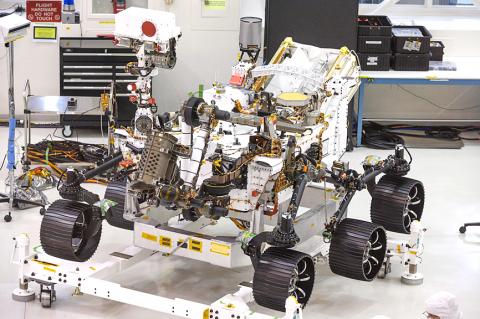A NASA robotic rover is nearing completion ahead of a journey next year to search for evidence of past life on Mars and lay the groundwork for the space agency’s mission to send humans into deep space.
The US space agency on Friday showed off its Mars 2020 rover, whose official name is to be chosen early next year.
NASA would in February ship the rover to Florida’s John F. Kennedy Space Center, where its three sections are to be fully assembled. A July launch would send the rover to a dry lake bed on Mars that is bigger than the island of Manhattan.

Photo: AFP
The six-wheeled, car-sized rover is to scour the base of Mars’ Jezero Crater, a 250m-deep crater thought to have been a lake the size of Lake Tahoe, once the craft lands in February 2021. The crater is believed to have an abundance of pristine sediments about 3.5 billion years old that scientists hope will hold fossils of Martian life.
“The trick, though, is that we’re looking for trace levels of chemicals from billions of years ago on Mars,” deputy project manager Matt Wallace told reporters.
The rover is to collect up to 30 soil samples to be picked up and returned to Earth by a future spacecraft planned by NASA.
“Once we have a sufficient set, we’ll put them down on the ground and another mission, which we hope to launch in 2026, will come, land on the surface, collect those samples and put them into a rocket, basically,” Wallace said.
Humans have never before returned sediment samples from Mars.
The findings of the rover’s research would be crucial to future human missions to the red planet, including the ability to make oxygen on the surface of Mars, Wallace said.
The rover is to carry equipment that can turn carbon dioxide, which is pervasive on Mars, into oxygen for breathing and as a propellant.
If successful, Mars 2020 would mark NASA’s fifth Martian rover to carry out a soft landing, having learned crucial lessons from the most recent rover, Curiosity, that landed on the planet’s surface in 2012 and continues to traverse a Martian plain southeast of the Jezero Crater.

A plan by Switzerland’s right-wing People’s Party to cap the population at 10 million has the backing of almost half the country, according to a poll before an expected vote next year. The party, which has long campaigned against immigration, argues that too-fast population growth is overwhelming housing, transport and public services. The level of support comes despite the government urging voters to reject it, warning that strict curbs would damage the economy and prosperity, as Swiss companies depend on foreign workers. The poll by newspaper group Tamedia/20 Minuten and released yesterday showed that 48 percent of the population plan to vote

PARLIAMENT CHAOS: Police forcibly removed Brazilian Deputy Glauber Braga after he called the legislation part of a ‘coup offensive’ and occupied the speaker’s chair Brazil’s lower house of Congress early yesterday approved a bill that could slash former Brazilian president Jair Bolsonaro’s prison sentence for plotting a coup, after efforts by a lawmaker to disrupt the proceedings sparked chaos in parliament. Bolsonaro has been serving a 27-year term since last month after his conviction for a scheme to stop Brazilian President Luiz Inacio Lula da Silva from taking office after the 2022 election. Lawmakers had been discussing a bill that would significantly reduce sentences for several crimes, including attempting a coup d’etat — opening up the prospect that Bolsonaro, 70, could have his sentence cut to

A powerful magnitude 7.6 earthquake shook Japan’s northeast region late on Monday, prompting tsunami warnings and orders for residents to evacuate. A tsunami as high as three metres (10 feet) could hit Japan’s northeastern coast after an earthquake with an estimated magnitude of 7.6 occurred offshore at 11:15 p.m. (1415 GMT), the Japan Meteorological Agency (JMA) said. Tsunami warnings were issued for the prefectures of Hokkaido, Aomori and Iwate, and a tsunami of 40cm had been observed at Aomori’s Mutsu Ogawara and Hokkaido’s Urakawa ports before midnight, JMA said. The epicentre of the quake was 80 km (50 miles) off the coast of

RELAXED: After talks on Ukraine and trade, the French president met with students while his wife visited pandas, after the pair parted ways with their Chinese counterparts French President Emmanuel Macron concluded his fourth state visit to China yesterday in Chengdu, striking a more relaxed note after tough discussions on Ukraine and trade with Chinese President Xi Jinping (習近平) a day earlier. Far from the imposing Great Hall of the People in Beijing where the two leaders held talks, Xi and China’s first lady, Peng Liyuan (彭麗媛), showed Macron and his wife Brigitte around the centuries-old Dujiangyan Dam, a World Heritage Site set against the mountainous landscape of Sichuan Province. Macron was told through an interpreter about the ancient irrigation system, which dates back to the third century